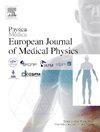Exploring the impact of filament density on the responsiveness of 3D-Printed bolus materials for high-energy photon radiotherapy
IF 3.3
3区 医学
Q1 RADIOLOGY, NUCLEAR MEDICINE & MEDICAL IMAGING
Physica Medica-European Journal of Medical Physics
Pub Date : 2024-11-01
DOI:10.1016/j.ejmp.2024.104849
引用次数: 0
Abstract
Background
3D-printed boluses in radiation therapy receive consideration for their ability to enhance treatment precision and patient comfort. Yet, thorough validation of 3D-printed boluses using various validation procedures and statistical analysis is missing. This study aims to determine the effectiveness of using 3D-printed boluses in radiation therapy.
Method
The CT Hounsfield Unit (HU) profiles of the 3D-printed materials were compared to those of the commercial bolus using the Eclipse Treatment Planning System (TPS) unit. Furthermore, absolute dose measurements were carried out to assess the efficacy of the 3D-printed samples by using concordance correlation coefficient to assess the agreement between 3D materials and the commercial bolus.
Results
The average HU profiles of 3D-printed materials were: −144.53 (ABS), −124.40 (ASA), 9.55 (PLA-P), −140.79 (Polycarbonate), −68.58 (PLA-S), and −113.159 (PET-G), respectively. PDD scans showed that air gaps between the bolus and surface shifted the maximum dose depth. Whereas dosimetry has shown that ASA and Polycarbonate are different in attenuation from other tested filaments. This limitation could affect their performance in specific applications within radiation therapy. The final analysis, using the TPS-generated datasets to assess the area under the dose curve in the build-up zone of each 3D-bolus, excluded ABS.
Conclusions
The results from PDD scans and dose assessments offer compelling proof that 3D-printed boluses are effective for delivering surface dosage and are like commercially available boluses. Moreover, specific materials showed a statistically significant improvement in delivering the dose. The results highlight the capability of 3D-printed boluses to enhance the effectiveness of radiation therapy.
探索长丝密度对用于高能光子放射治疗的三维打印栓剂材料响应性的影响。
背景:三维打印放射治疗栓因其能够提高治疗精确度和患者舒适度而受到关注。然而,目前还没有利用各种验证程序和统计分析对 3D 打印栓剂进行彻底验证。本研究旨在确定在放射治疗中使用 3D 打印栓剂的有效性:方法:使用 Eclipse 治疗计划系统(TPS)装置,将三维打印材料的 CT Hounsfield 单位(HU)曲线与商用栓剂的 CT Hounsfield 单位(HU)曲线进行比较。此外,还进行了绝对剂量测量,以评估三维打印样本的疗效:结果:3D打印材料的平均HU曲线为结果:三维打印材料的平均 HU 值分别为:-144.53(ABS)、-124.40(ASA)、9.55(PLA-P)、-140.79(聚碳酸酯)、-68.58(PLA-S)和-113.159(PET-G)。PDD 扫描显示,栓剂和表面之间的空气间隙改变了最大剂量深度。而剂量测定显示,ASA 和聚碳酸酯在衰减方面与其他测试丝不同。这一限制可能会影响它们在放射治疗特定应用中的性能。使用 TPS 生成的数据集进行最终分析,以评估每个三维脆片堆积区的剂量曲线下面积,结果排除了 ABS:PDD扫描和剂量评估的结果有力地证明了三维打印栓剂能有效地提供表面剂量,并且与市面上的栓剂相似。此外,特定材料在投放剂量方面有显著的统计学改进。这些结果凸显了三维打印栓剂提高放射治疗效果的能力。
本文章由计算机程序翻译,如有差异,请以英文原文为准。
求助全文
约1分钟内获得全文
求助全文
来源期刊
CiteScore
6.80
自引率
14.70%
发文量
493
审稿时长
78 days
期刊介绍:
Physica Medica, European Journal of Medical Physics, publishing with Elsevier from 2007, provides an international forum for research and reviews on the following main topics:
Medical Imaging
Radiation Therapy
Radiation Protection
Measuring Systems and Signal Processing
Education and training in Medical Physics
Professional issues in Medical Physics.

 求助内容:
求助内容: 应助结果提醒方式:
应助结果提醒方式:


